Key takeaways:
- Understanding fundamental concepts like market cap, liquidity, and chart patterns is essential for successful crypto trading.
- Choosing the right cryptocurrency involves thorough research and analysis of the technology, community engagement, market behavior, and the development team.
- Risk management techniques, including setting stop-loss orders and diversifying portfolios, are crucial to protecting investments and maintaining trading confidence.
- Reflecting on past trades, emotions, and sharing experiences with fellow traders can enhance trading strategies and promote personal growth.
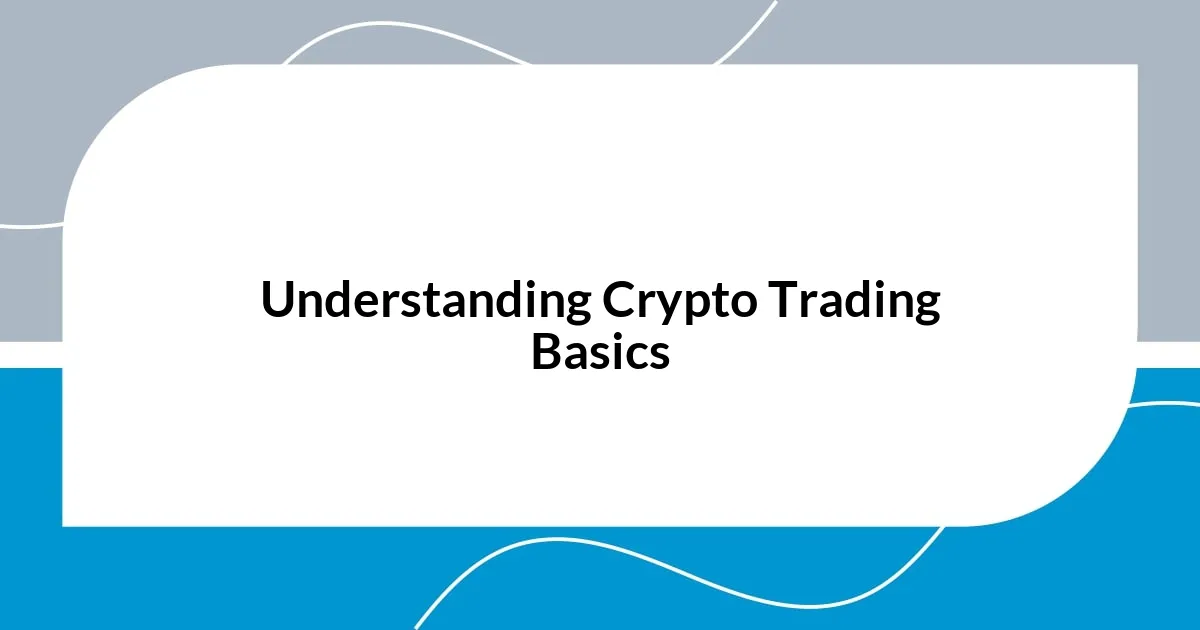
Understanding Crypto Trading Basics
Understanding the basics of crypto trading can feel overwhelming at first, but it doesn’t have to be. I remember my initial confusion surrounding terms like “market cap” and “liquidity” – it felt like trying to decode a foreign language. However, once I started breaking these concepts down, everything began to click into place.
At its core, crypto trading involves buying and selling digital currencies based on market trends and personal research. I find it fascinating how each trade is influenced by various factors, such as market sentiment or regulatory news. Have you ever considered how a single tweet can swing the value of a cryptocurrency dramatically? It’s a vivid reminder that this space is both fluid and unpredictable.
One crucial aspect I’ve learned is the importance of understanding chart patterns. When I first began deciphering candlestick charts, it was like learning to read music; at times, it felt chaotic but incredibly rewarding once I grasped the rhythm. Seeing certain patterns emerge often leads me to trust my instincts more, which has made all the difference in my trading strategy. How about you? Have you found any particular methods or tools that resonate with your trading style?

Choosing the Right Cryptocurrency
Choosing the right cryptocurrency can feel like picking a needle from a haystack. I’ve had my share of hits and misses—like the time I put my faith in a trendy altcoin that plummeted the next day. The excitement can be intoxicating, but doing my homework beforehand has saved me from more than a few sleepless nights. I always look for specific qualities before diving in.
- Fundamental Analysis: I examine the technology behind the coin. What problems does it solve?
- Community Engagement: A strong community often indicates potential longevity. I keep an eye on forums and social media buzz.
- Market Behavior: I analyze past price trends. Patterns help me gauge how a cryptocurrency might react under different conditions.
- Development Team: A transparent and active team can inspire confidence. I seek out information about the project’s leaders and their track record.
It’s crucial to align my choices with my trading strategy. I once got too emotionally attached to an underperforming cryptocurrency, ignoring the glaring signs that it was time to let it go. Now, I remind myself to treat each choice with the analysis it deserves, marrying my intuition with solid research.
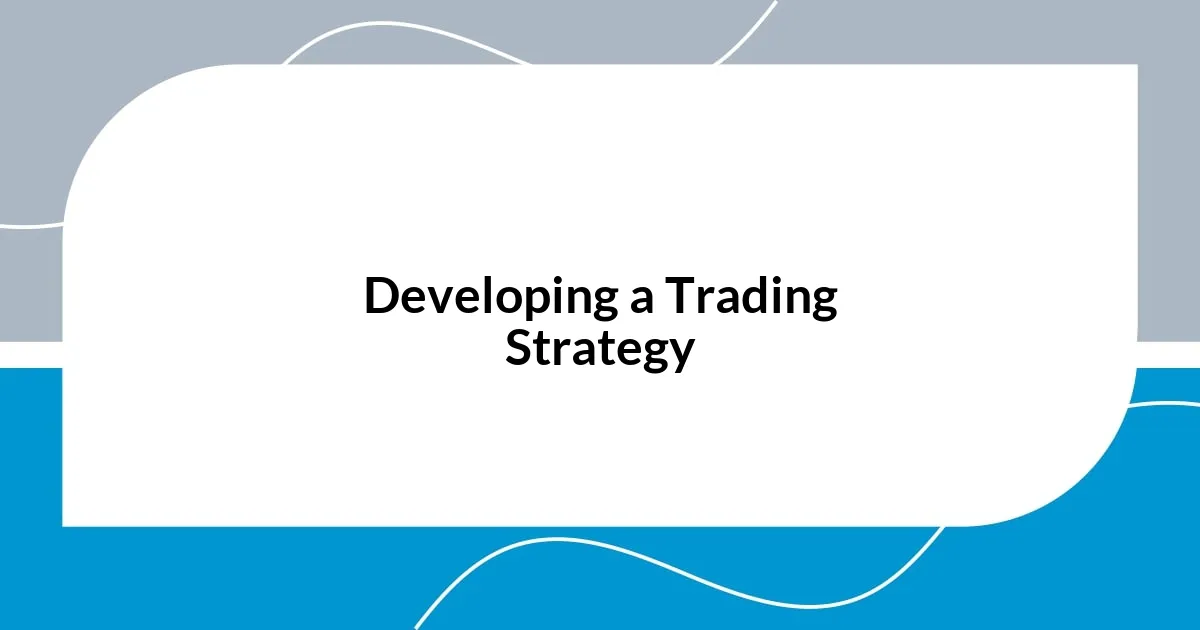
Developing a Trading Strategy
When it comes to developing a trading strategy, I believe it’s essential to first define one’s goals. Are you seeking quick profits through day trading, or are you more interested in long-term investments? I had to grapple with this decision early on. Initially, I was caught up in the fast-paced nature of day trading, but I found myself exhausted and anxious, constantly glued to the screen. Transitioning to a more patient, long-term approach significantly eased my stress and aligned my strategy with my lifestyle.
Implementing risk management techniques can’t be underestimated. I remember an instance where a sudden market dip led to significant losses because I hadn’t set stop-loss orders. Since then, I’ve adopted a rule of never risking more than 1% of my total capital on any given trade. This consistency has not only safeguarded my investments but has also given me the confidence to take calculated risks without the constant fear of losing everything. How do you manage risk in your trading activities?
Lastly, backtesting your strategies can be a game-changer. I recall when I first started, I would execute trades based on gut feelings. However, after experimenting with backtesting, analyzing historical price movements, and how they would have performed, I discovered what truly worked for me. It’s like fine-tuning an instrument; the result is a trading strategy that feels both personalized and effective. Have you ever tried backtesting your strategies? It can reveal surprising insights that could enhance your trading journey.
| Trading Strategy Component | Description |
|---|---|
| Define Your Goals | Determine if you’re focusing on short-term gains or long-term growth. |
| Risk Management | Implement rules such as stop-loss orders to minimize potential losses. |
| Backtesting | Analyze historical data to refine and validate your trading strategies. |
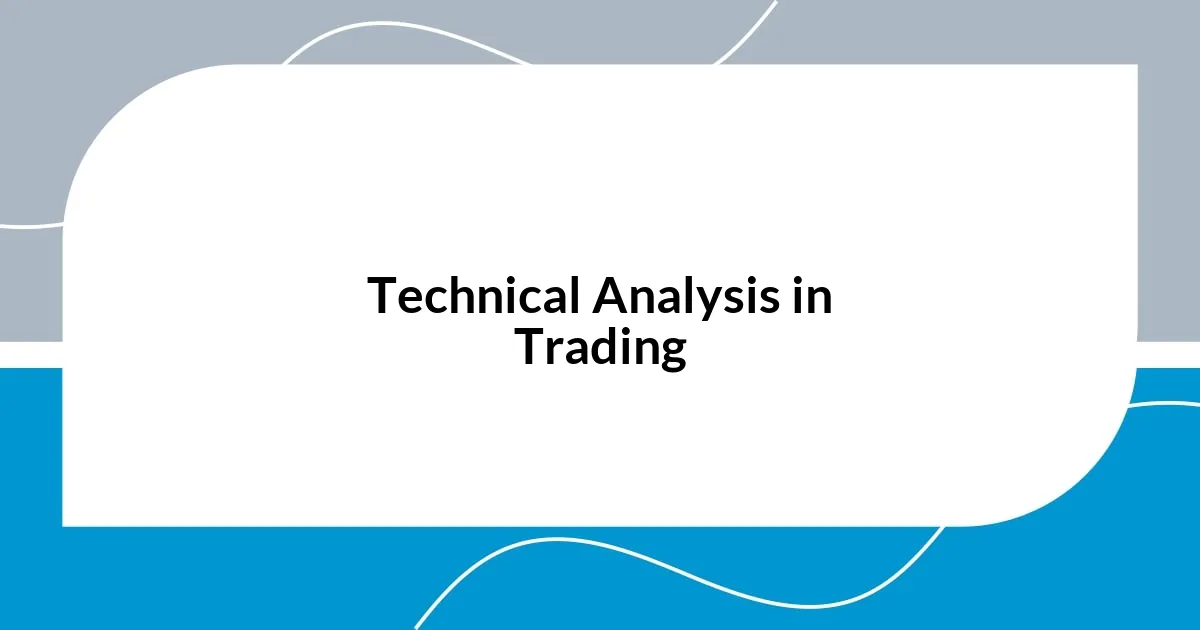
Technical Analysis in Trading
I can’t stress enough how pivotal technical analysis has been in my trading journey. For me, it goes beyond just numbers and charts; it’s about understanding market psychology. When I first started, I relied heavily on candlestick patterns—each shape tells a story. I remember the thrill of recognizing a bullish engulfing pattern; it fueled my confidence to make a timely investment. Have you ever felt that rush of clarity when you decode a chart?
Using indicators like the Relative Strength Index (RSI) has also shaped my trading decisions. Initially, I found it overwhelming with all the available tools, but over time, I’ve learned to hone in on a few key indicators that resonate with my trading style. A low RSI often hints that a cryptocurrency is oversold, prompting me to consider buying. Adjusting my parameters based on my personal experience has made all the difference. It’s like finding the right lens to view the market—suddenly, everything becomes clearer.
Finally, I love combining technical analysis with trend lines. These lines guide my mindset, helping me visualize possible support and resistance levels. There was a time I missed several profitable trades because I overlooked a key trend line, leading to unnecessary regret. Now, I draw them with care, treating them as essential checkpoints in my trading process. Can you relate to those moments when you realize the importance of a simple tool? A few lines on a chart can be game-changers!
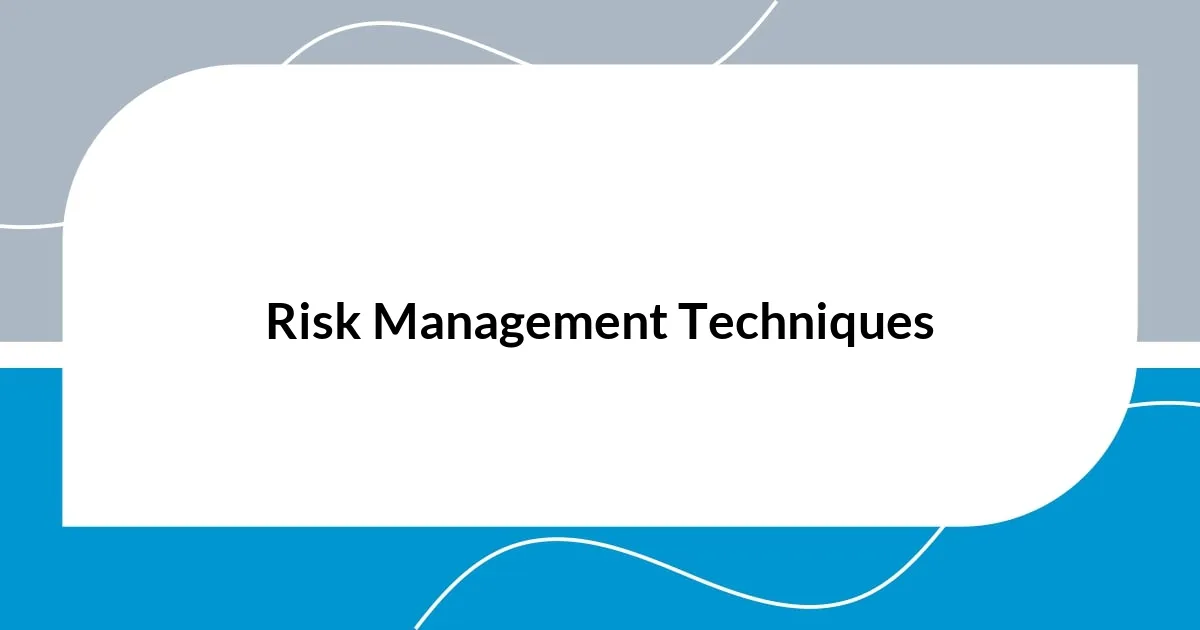
Risk Management Techniques
Managing risk in crypto trading is something that I’ve learned to prioritize over the years. One of the most effective techniques I’ve adopted is setting a clear stop-loss order for every trade I make. I remember the first time I implemented this; I was hesitant, thinking it would limit my profits. However, after experiencing a sudden downturn in the market, I realized that my stop-loss had actually protected my capital and allowed me to live to trade another day. Does that resonate with your own experiences in trading?
Diversifying my portfolio has also been a crucial risk management technique for me. I used to put all my eggs in one basket, focusing solely on a single cryptocurrency. This approach was nerve-wracking, especially during volatile times. Now, I’ve learned that spreading my investments across different assets not only reduces my overall risk but also gives me peace of mind. Have you tried diversifying? It can truly change how you approach the market.
Another technique that has served me well is regularly revisiting and adjusting my risk-to-reward ratios. Initially, I didn’t pay much attention to this metric, chasing after potential gains without considering possible losses. One day, I found myself in a losing position that could have been avoided if I had set a more favorable ratio. Now, I take the time to assess each trading opportunity critically, making sure the potential rewards significantly outweigh the risks. Have you ever recalibrated your approach and felt like a weight was lifted? It’s incredible how small adjustments can lead to better outcomes.
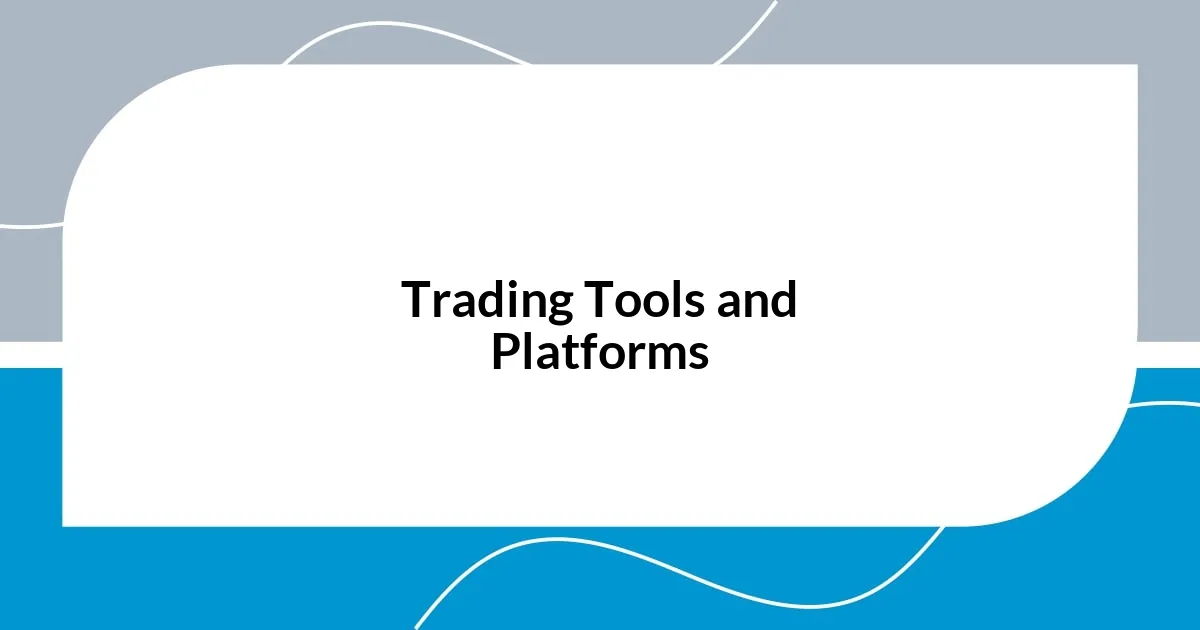
Trading Tools and Platforms
When it comes to trading tools and platforms, my choice of the right exchange has significantly influenced my trading efficiency. I remember setting up my first account on a popular platform—navigating through all the features felt overwhelming. However, finding a user-friendly interface where I could easily access all my tools made a world of difference. Have you ever experienced that sense of relief when you finally find a platform that just clicks for you?
Using charting tools within these platforms has been another game-changer. I’ve experimented with several options and eventually settled on one that allows for extensive customization. The ability to overlay multiple indicators helps me analyze price action in real time. I still recall a trade where adjusting my charting setup led me to recognize a bullish divergence I might have otherwise missed. Does your platform offer tools that ignite your trading intuition?
I also began utilizing mobile trading apps for their convenience. Initially, I was skeptical about trading on my phone, but I soon discovered it allows me to stay connected to the market anytime and anywhere. This flexibility has helped me capitalize on sudden price movements while commuting or even during family gatherings. Isn’t it empowering to know that you can manage your trades just about anywhere? The blend of power and ease of access creates opportunities that I once thought were only for desktop users.
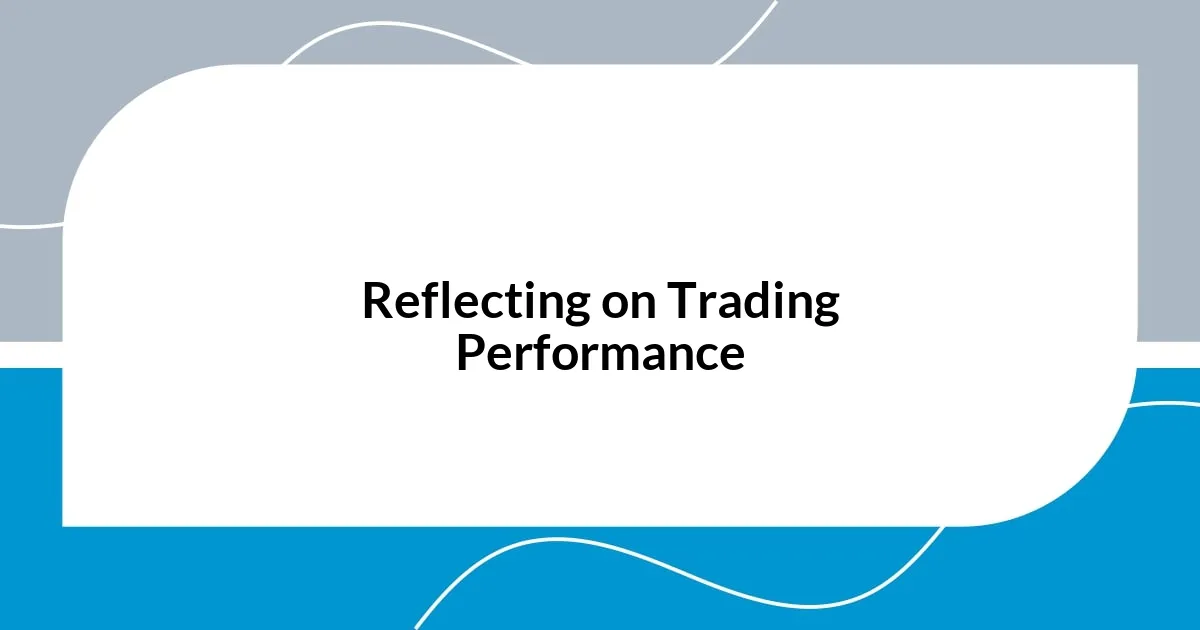
Reflecting on Trading Performance
Reflecting on my trading performance has been an enlightening experience. I often look back at my trades to discern patterns and understand what truly worked. For instance, I remember a period when I was on a winning streak. I became complacent and ignored my previous strategies. That oversight led to losses that felt incredibly frustrating. Have you ever been caught in that cycle of overconfidence? It’s eye-opening to realize how vital it is to stay grounded.
I routinely review my trading journal to see where my emotional states influenced my decisions. There’s something about reading my own thoughts during those pivotal moments that brings clarity. There was a time when I felt pressure to act quickly during a market surge, and my impulsive decisions led to regret. Reflecting on those emotions helps me identify triggers that can derail my strategy. It’s intriguing how this self-awareness sharpened my approach. Have you kept track of your emotions while trading?
Moreover, I’ve found it beneficial to share insights with fellow traders about our performance highs and lows. Listening to their experiences and contrasting them with my own adds a valuable perspective. I recall a discussion where someone talked about a colossal loss that made me rethink my reaction to similar situations. We often think we’re alone in our struggles, but sharing these reflections encourages growth. How often do we lean on our community for support? Embracing this aspect of trading has certainly enriched my journey.